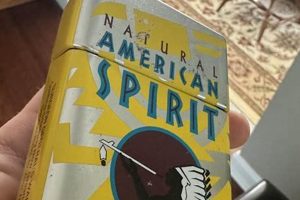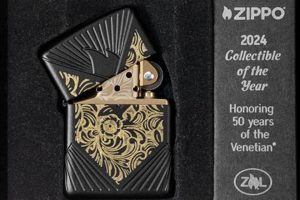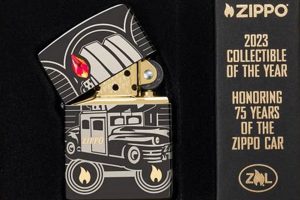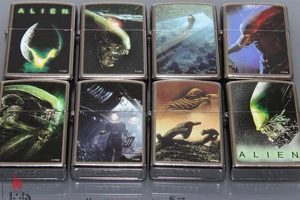A curated assembly of vintage Zippo lighters represents a tangible connection to the past. These pocket-sized pieces of history, often bearing unique designs, engravings, or military insignia, can reflect specific eras, advertising campaigns, or personal stories. For instance, a lighter from World War II might feature a soldier’s engraved initials or a patriotic motif, offering a glimpse into that individual’s experiences.
Assembled over time, these curated sets possess historical, aesthetic, and potentially significant monetary value. Beyond their functionality, vintage lighters serve as miniature canvases showcasing artistic trends, manufacturing techniques, and social changes. The evolution of their design, from simple brushed chrome to elaborate enamel inlays, mirrors broader cultural shifts. Furthermore, the rarity and condition of specific models contribute to their desirability among collectors. Preserving these artifacts contributes to a wider appreciation of industrial design and cultural heritage.
This exploration delves into various aspects of vintage Zippo lighter collecting, including identifying valuable models, proper preservation techniques, and the historical significance of specific designs. It aims to provide a comprehensive guide for both seasoned collectors and those newly interested in these fascinating relics.
Tips for Vintage Zippo Lighter Collecting
Careful consideration of several factors contributes to successful and rewarding acquisition and preservation of vintage lighters.
Tip 1: Authentication is Paramount: Scrutinize potential acquisitions for telltale signs of authenticity. Examine the bottom stamp for date codes and genuine markings. Compare the lighter’s construction and finish to established references for the specific model.
Tip 2: Condition Matters: Assess the lighter’s overall condition, noting any brassing, scratches, or dents. While some wear adds character, significant damage can impact value. Unused, mint-condition lighters command premium prices.
Tip 3: Research Extensively: Knowledge is crucial for discerning valuable models from common ones. Specialized books, online forums, and reputable dealers offer valuable resources for identifying rare variations and assessing fair market prices.
Tip 4: Handle with Care: Vintage lighters require gentle handling. Avoid harsh chemicals or abrasive cleaning methods, which can damage the finish. Store lighters in a cool, dry environment away from direct sunlight.
Tip 5: Focus on a Niche: Specializing in a specific era, design, or theme (e.g., military lighters, advertising lighters) can provide a more focused collecting experience.
Tip 6: Network with Other Collectors: Joining collector clubs or online forums provides opportunities for sharing knowledge, discovering rare finds, and building a community.
Tip 7: Patience is Key: Building a significant collection takes time and dedication. Avoid impulsive purchases and focus on acquiring quality pieces that align with collecting goals.
By adhering to these guidelines, enthusiasts can cultivate collections that offer both personal enjoyment and potential long-term investment value.
These insights provide a foundation for navigating the world of vintage Zippo lighter collecting. The subsequent sections will delve deeper into specific areas of interest for both novice and experienced collectors.
1. Rarity
Rarity stands as a cornerstone of value within vintage Zippo lighter collecting. The scarcity of a particular model, stemming from limited production numbers, specific historical context, or unique design elements, directly correlates with its desirability and potential market value. Cause and effect are clearly linked: lower availability increases demand, driving prices upward. For instance, a Zippo produced for a short-lived advertising campaign or a commemorative edition released in limited quantities will typically hold greater value than a standard production model from the same period. Similarly, lighters exhibiting rare factory errors or unique prototypes can achieve extraordinary valuations due to their scarcity.
Understanding the nuances of rarity is essential for informed collecting. Factors influencing rarity include production dates, special editions, commemorative releases, military issue variations, and unique advertising designs. The presence of original packaging or accompanying documentation can further enhance a lighter’s rarity and value. For example, a Zippo from the 1930s, especially one in pristine condition with its original box, is inherently rarer and more valuable than a mass-produced model from the 1960s, even if the latter features an attractive design. This understanding empowers collectors to make informed decisions about acquisitions and potential investment value.
In conclusion, rarity functions as a critical driver of value in the realm of vintage Zippo lighter collecting. Recognizing the factors that contribute to rarity, researching specific models, and understanding the interplay of supply and demand are essential for building a valuable and historically significant collection. The pursuit of rare examples provides a challenging yet rewarding aspect of collecting, ultimately linking the tangible object to a specific historical moment or design trend.
2. Condition
Condition significantly impacts the value and desirability within vintage Zippo lighter collections. A spectrum of conditions exists, ranging from mint, indicating an unused state with pristine surfaces and original finish, to heavily worn, exhibiting significant brassing, scratches, dents, and potential mechanical wear. The principle of cause and effect directly applies: better condition typically translates to higher value, reflecting careful preservation and minimal exposure to the elements. For example, two identical Zippo lighters from the same production year, one exhibiting a near-mint state and the other showing heavy wear, will command vastly different prices in the collector market. The former, having escaped the ravages of time and use, retains its original character and historical integrity, thus appealing to collectors seeking pristine examples. The latter, while potentially possessing historical value, carries the marks of its journey, diminishing its desirability and market value.
The importance of condition as a component of an old Zippo lighter collection cannot be overstated. Collectors prioritize well-preserved examples not only for aesthetic appeal but also for their historical relevance. A mint-condition lighter offers a glimpse into the past, representing the manufacturer’s original intent and design. The condition also plays a crucial role in authentication. Examining the finish, the presence of original markings, and the mechanical integrity aids in verifying a lighter’s authenticity and distinguishing it from potential reproductions or altered pieces. Consider a scenario where a collector encounters two seemingly identical wartime Zippos. One exhibits a uniform patina consistent with its age, while the other displays an artificially aged finish, raising concerns about authenticity. In this context, careful evaluation of condition becomes a critical tool for discerning genuine artifacts from potentially deceptive reproductions.
Understanding the influence of condition enables collectors to make informed decisions about acquisitions and appreciate the nuances of value within vintage Zippo lighter collections. While a well-worn lighter might hold sentimental value or represent a specific historical narrative, recognizing the market dynamics related to condition is paramount for building a collection that balances historical interest with potential investment value. Preservation through proper storage and handling further underscores the importance of condition, ensuring the longevity and historical integrity of these collectible items. The pursuit of well-preserved examples, combined with a deep understanding of the factors influencing condition, enhances the collector’s ability to appreciate the artistry, history, and market dynamics associated with vintage Zippo lighters.
3. Authenticity
Authenticity serves as a critical cornerstone within the realm of vintage Zippo lighter collecting. Establishing the genuine nature of a lighter is paramount for determining its historical significance, collectibility, and ultimately, its value. Counterfeit lighters and unauthorized reproductions exist within the market, posing challenges for collectors seeking genuine artifacts. Discerning authentic pieces from imitations requires careful examination, knowledge of manufacturing processes, and awareness of key identifying features. The pursuit of authenticity safeguards the integrity of collections and ensures that the historical and cultural significance of these items remains untarnished.
- Bottom Stamps and Date Codes:
Genuine Zippo lighters bear bottom stamps indicating the manufacturer and date of production. These markings evolve over time, providing crucial clues for authentication. Variations in font, spacing, and depth of stamping can help distinguish authentic lighters from counterfeits. Collectors consult comprehensive reference guides to verify the accuracy of bottom stamps and date codes against known production periods. For instance, a lighter purportedly from the 1940s bearing a bottom stamp inconsistent with that era’s manufacturing practices raises immediate concerns about its authenticity. Careful examination of these markings provides a primary defense against acquiring counterfeit or misrepresented pieces.
- Case Construction and Materials:
Analyzing the construction and materials of a lighters case provides further insights into its authenticity. Genuine Zippo cases exhibit specific characteristics regarding metal thickness, hinge design, and finishing techniques. Variations in these elements can indicate non-genuine production. For example, a lighter with an unusually thin case or a hinge mechanism that differs from established Zippo designs raises red flags. Knowledge of period-specific manufacturing techniques, combined with careful observation, empowers collectors to identify potential inconsistencies that might signal a reproduction.
- Insert Markings and Components:
The lighter insert, the internal mechanism responsible for generating the flame, contains further indicators of authenticity. Genuine Zippo inserts bear specific markings and utilize particular component designs that evolve over time. Scrutinizing these details helps distinguish authentic lighters from those assembled with non-genuine parts. For example, the presence of incorrect markings on the flint wheel or variations in the chimney design suggests potential issues with authenticity. A thorough examination of the insert is essential for verifying a lighter’s genuine nature.
- Provenance and Documentation:
Establishing provenance, the documented history of an item’s ownership, provides added assurance of authenticity, particularly for rare or historically significant lighters. Original packaging, accompanying paperwork, or a documented chain of custody enhance a lighters credibility and value. While not always available, provenance offers valuable context and strengthens the case for authenticity. For example, a wartime Zippo with accompanying military documentation or a lighter with a documented history of ownership by a notable figure significantly strengthens its authenticity and historical significance.
These interconnected facets of authenticity underscore the importance of careful research and scrutiny within vintage Zippo lighter collecting. By considering bottom stamps, case construction, insert details, and available provenance, collectors can confidently navigate the complexities of authentication and build collections comprised of genuine artifacts. The pursuit of authenticity preserves the historical integrity of these items, ensuring that they remain tangible links to specific eras and cultural moments.
4. Historical Context
Historical context provides a crucial framework for understanding the significance of vintage Zippo lighter collections. These seemingly simple objects serve as tangible links to specific eras, reflecting cultural trends, historical events, and technological advancements. Examining the historical context surrounding a lighter’s production date, design motifs, and intended use enhances appreciation for its place within a broader historical narrative. The following facets illuminate the multifaceted relationship between historical context and vintage Zippo lighter collecting.
- Wartime Production and Military Use
Zippo lighters gained prominence during World War II, becoming essential tools for soldiers. Military-issued and personally carried lighters often bear unit insignia, personalized engravings, or evidence of battlefield use, providing poignant connections to individual experiences and the broader conflict. For example, a Zippo carried by a soldier during the D-Day landings holds immense historical significance, representing a tangible link to a pivotal moment in history. These wartime lighters offer insights into the daily lives of soldiers, the challenges they faced, and the historical context in which they served.
- Advertising and Promotional Campaigns
Throughout their history, Zippo lighters served as canvases for advertising and promotional campaigns. Lighters bearing company logos, product branding, or commemorative designs reflect the marketing trends and consumer culture of specific periods. For instance, a Zippo advertising a popular beverage brand from the 1950s offers a glimpse into the advertising aesthetics and consumer preferences of that era. These advertising lighters provide valuable insights into the evolution of marketing strategies and the cultural landscape in which they were deployed.
- Social and Cultural Trends
Zippo lighter designs often reflect broader social and cultural trends. From Art Deco motifs of the 1930s to the psychedelic patterns of the 1960s, lighters mirror the prevailing artistic styles and cultural sensibilities of their respective periods. For example, a Zippo featuring a peace symbol from the 1970s reflects the anti-war sentiment and counterculture movements of that decade. These design trends provide a visual record of evolving cultural values and artistic expression.
- Technological Advancements and Manufacturing Processes
The evolution of Zippo lighter design and manufacturing processes reflects technological advancements over time. Changes in case materials, hinge designs, and finishing techniques provide insights into the company’s innovation and adaptation to changing manufacturing capabilities. For instance, the introduction of new plating methods or the use of different metal alloys reflects advancements in materials science and manufacturing technologies. These technological developments contribute to the historical narrative surrounding Zippo lighters and provide a tangible record of industrial progress.
By considering these interconnected facets of historical context, collectors gain a deeper appreciation for the significance of vintage Zippo lighters. These objects transcend their utilitarian function, becoming historical artifacts that offer insights into wartime experiences, advertising trends, social movements, and technological advancements. The pursuit of historical context enriches the collecting experience, transforming individual lighters into tangible representations of specific historical moments and cultural currents. Furthermore, understanding the historical context surrounding a particular lighter enhances its value, both monetarily and as a historical artifact. This connection to the past elevates vintage Zippo lighter collecting beyond mere accumulation, transforming it into a pursuit of historical understanding and cultural preservation.
5. Preservation
Preservation represents a critical aspect of maintaining the value, historical integrity, and aesthetic appeal of vintage Zippo lighter collections. Proper preservation techniques mitigate the detrimental effects of time, environmental factors, and handling, ensuring the longevity of these collectible items. Neglecting preservation can lead to irreversible damage, diminishing a lighter’s value and historical significance. Implementing appropriate preservation strategies safeguards these tangible pieces of history for future generations, allowing them to appreciate the craftsmanship, design, and historical context embodied within each lighter.
- Storage Environment
Creating a suitable storage environment is fundamental to preserving vintage Zippo lighters. A cool, dry, and stable environment minimizes the risk of corrosion, tarnish, and damage to delicate finishes. Avoid storing lighters in humid areas or locations subject to temperature fluctuations. Utilizing specialized storage cases or protective sleeves further safeguards against scratches, dents, and exposure to airborne contaminants. For example, storing lighters in a climate-controlled display case, away from direct sunlight and humidity, significantly reduces the risk of deterioration. Proper storage ensures that lighters retain their original condition and historical integrity over time.
- Handling Techniques
Careful handling practices are essential for preventing damage to vintage Zippo lighters. Avoid using harsh chemicals or abrasive cleaning methods, which can strip original finishes and devalue the lighter. Handle lighters with clean hands to minimize the transfer of oils and contaminants. When examining or displaying lighters, use gloves to prevent fingerprints and preserve the pristine condition of the surface. For instance, handling a rare, mint-condition lighter with bare hands can leave fingerprints that etch into the finish over time, diminishing its value. Gentle handling techniques preserve the lighter’s original condition and protect its delicate finishes.
- Cleaning and Maintenance
Appropriate cleaning and maintenance procedures contribute to the long-term preservation of vintage Zippo lighters. Use soft cloths and specialized cleaning solutions designed for delicate metal finishes to remove dirt and grime. Avoid excessive polishing, which can wear away the original finish. Regularly inspect lighters for signs of wear or damage and address any issues promptly to prevent further deterioration. For example, carefully cleaning the exterior of a lighter with a soft cloth and a non-abrasive metal cleaner can remove tarnish and restore its original shine without damaging the finish. Regular maintenance preserves the lighter’s functionality and aesthetic appeal.
- Documentation and Cataloging
Documenting and cataloging vintage Zippo lighters provides a valuable record of the collection and aids in preservation efforts. Maintaining a detailed inventory, including photographs, descriptions, and historical information about each lighter, enhances the collection’s value and facilitates insurance appraisals. Documentation also helps track the condition of lighters over time, allowing collectors to identify and address any potential preservation issues. For instance, maintaining a photographic record of a lighter’s condition upon acquisition provides a baseline for comparison and helps identify any subsequent changes or damage. Thorough documentation safeguards the collection and provides a valuable resource for future generations.
These interconnected facets of preservation underscore the commitment required to maintain the integrity and value of vintage Zippo lighter collections. By implementing proper storage techniques, handling practices, cleaning procedures, and documentation strategies, collectors ensure that these historical artifacts remain in optimal condition for years to come. Preservation not only protects the monetary value of a collection but also safeguards its historical significance, allowing future generations to appreciate the craftsmanship, design, and cultural context embodied within each lighter. The meticulous attention to preservation elevates vintage Zippo lighter collecting beyond mere accumulation, transforming it into a form of historical preservation and cultural stewardship.
Frequently Asked Questions
This section addresses common inquiries regarding vintage Zippo lighter collecting, providing concise yet informative responses to facilitate a deeper understanding of this specialized field.
Question 1: How can one determine the date of manufacture of a vintage Zippo lighter?
The bottom stamp of a Zippo lighter provides key information regarding its date of manufacture. Specific markings, including letters, numbers, and symbols, correspond to different production periods. Consulting a comprehensive date code chart or a reputable Zippo identification guide is essential for accurate dating.
Question 2: What factors contribute most significantly to a vintage Zippo lighter’s value?
Rarity, condition, and historical significance are primary determinants of value. Limited production numbers, unique designs, wartime provenance, or association with specific historical events can significantly enhance a lighter’s value. Pristine condition further amplifies desirability and market price.
Question 3: How can collectors distinguish authentic vintage Zippo lighters from counterfeits?
Careful examination of the bottom stamp, case construction, insert markings, and overall quality helps identify genuine Zippo lighters. Comparing these features to established reference materials and consulting with experienced collectors aids in authentication. Provenance documentation, when available, provides additional assurance of authenticity.
Question 4: What are the most effective methods for preserving vintage Zippo lighters and preventing damage?
Storing lighters in a cool, dry, and stable environment minimizes the risk of corrosion and damage. Gentle handling, avoiding harsh chemicals, and using appropriate cleaning methods preserve the lighter’s finish and mechanical integrity. Specialized storage cases or protective sleeves offer additional protection.
Question 5: Where can individuals acquire authentic vintage Zippo lighters for their collections?
Reputable antique shops, specialized dealers, online auction platforms, and collector forums represent potential sources for acquiring vintage Zippo lighters. Thorough research, careful authentication, and comparison shopping are essential for ensuring the acquisition of genuine pieces at fair market prices.
Question 6: Are vintage Zippo lighters considered a worthwhile investment?
While certain rare and historically significant Zippo lighters can appreciate in value over time, approaching collecting solely as an investment carries inherent risks. Market fluctuations, changing collector demand, and the potential for encountering counterfeits require careful consideration. Building a collection based on personal interest and historical significance provides a more sustainable approach to collecting.
By addressing these common queries, this FAQ section aims to provide a foundational understanding of the key considerations within vintage Zippo lighter collecting. Informed decision-making, based on research and careful evaluation, ensures a rewarding and enriching collecting experience.
The following section explores specific notable models and their historical significance within the broader context of vintage Zippo lighter collecting.
Old Zippo Lighter Collection
Exploration of a vintage Zippo lighter collection reveals a multifaceted intersection of history, craftsmanship, and collecting. From the wartime trenches to advertising campaigns and evolving cultural trends, these pocket-sized artifacts offer tangible connections to the past. Rarity, condition, and authenticity stand as critical pillars supporting their value within the collector market. Preservation through meticulous storage, handling, and maintenance ensures the longevity of these historical relics. Understanding the historical context surrounding specific models enriches appreciation for their significance, transforming a collection into a curated timeline reflecting historical events, social movements, and technological advancements.
The enduring appeal of vintage Zippo lighters lies not solely in their utilitarian function, but in their capacity to ignite a deeper understanding of bygone eras. These miniature metal canvases bear witness to historical narratives, personal stories, and the evolving tapestry of human experience. Careful consideration of the factors influencing their value and historical significance elevates collecting beyond mere acquisition, transforming it into a journey of historical preservation and cultural appreciation. Continued research, meticulous authentication, and a commitment to responsible collecting practices will ensure that these tangible pieces of history continue to illuminate the past for generations to come.







